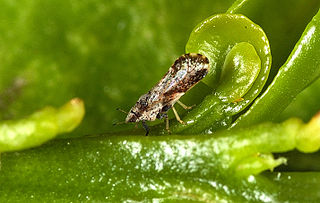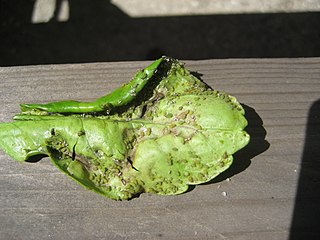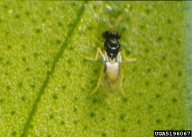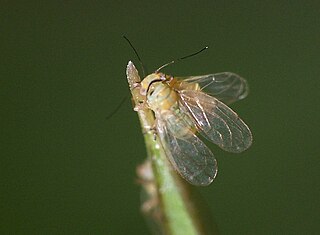Related Research Articles

Citrus production encompasses the production of citrus fruit, which are the highest-value fruit crop in terms of international trade. There are two main markets for citrus fruit:

Psyllidae, the jumping plant lice or psyllids, are a family of small plant-feeding insects that tend to be very host-specific, i.e. each plant-louse species only feeds on one plant species (monophagous) or feeds on a few closely related plants (oligophagous). Together with aphids, phylloxerans, scale insects and whiteflies, they form the group called Sternorrhyncha, which is considered to be the most "primitive" group within the true bugs (Hemiptera). They have traditionally been considered a single family, Psyllidae, but recent classifications divide the group into a total of seven families; the present restricted definition still includes more than 70 genera in the Psyllidae. Psyllid fossils have been found from the Early Permian before the flowering plants evolved. The explosive diversification of the flowering plants in the Cretaceous was paralleled by a massive diversification of associated insects, and many of the morphological and metabolic characters that the flowering plants exhibit may have evolved as defenses against herbivorous insects.

In biology, a lerp is a structure of crystallized honeydew produced by larvae of psyllid bugs as a protective cover. These animals are commonly referred to as lerp insects, of which there are over 300 species in Australia.

Colophospermum mopane, commonly called mopane, mopani, balsam tree, butterfly tree, or turpentine tree, is a tree in the legume family (Fabaceae), that grows in hot, dry, low-lying areas, 200 to 1,150 metres in elevation, in the far northern parts of southern Africa. The tree only occurs in Africa and is the only species in genus Colophospermum. Its distinctive butterfly-shaped (bifoliate) leaf and thin seed pod make it easy to identify. In terms of human use it is, together with camel thorn and leadwood, one of the three regionally important firewood trees.

Citrus greening disease is a disease of citrus caused by a vector-transmitted pathogen. The causative agents are motile bacteria, Liberibacter spp. The disease is vectored and transmitted by the Asian citrus psyllid, Diaphorina citri, and the African citrus psyllid, Trioza erytreae, also known as the two-spotted citrus psyllid. It has also been shown to be graft-transmissible. Three different types of HLB are currently known: the heat-tolerant Asian form, and the heat-sensitive African and American forms. The disease was first described in 1929 and first reported in China in 1943. The African variation was first reported in 1947 in South Africa, where it is still widespread. Eventually, it affected the United States, reaching Florida in 2005. Within three years, it had spread to the majority of citrus farms. The rapid increase in this disease has threatened the citrus industry not only in Florida, but the entire US. As of 2009, 33 countries have reported HLB infection in their citrus crop.

Leucaena leucocephala is a small fast-growing mimosoid tree native to southern Mexico and northern Central America and is now naturalized throughout the tropics including parts of Asia.

An orange is a fruit of various citrus species in the family Rutaceae ; it primarily refers to Citrus × sinensis, which is also called sweet orange, to distinguish it from the related Citrus × aurantium, referred to as bitter orange. The sweet orange reproduces asexually ; varieties of sweet orange arise through mutations.

Psylla pyri, commonly known as the pear psylla or pear psyllid, is an insect in the family Psyllidae. Originating in Europe and Asia, it has spread to North America. It is a pest of pear trees, sucking the sap, damaging the foliage, flowers and fruit and diminishing the crop.

Cacopsylla melanoneura is an insect of the Psyllidae family. It mainly feeds on Hawthorn. The insect will also feed on apple trees and is considered the main vector of the phytoplasma disease "Ca. Phytoplasma mali" in northwestern Italy.

Acizzia uncatoides is a species of psyllid native to Australia where it feeds primarily on Acacia and some Albizia species. It is present in many parts of the world where it infests these plant species, presumably introduced with the plants. It is not generally regarded as a pest species although it can proliferate to high numbers. Generalist psyllid predators also feed on this species.

Diaphorina citri, the Asian citrus psyllid, is a sap-sucking, hemipteran bug in the family Psyllidae. It is one of two confirmed vectors of citrus greening disease. It has a wide distribution in southern Asia and has spread to other citrus growing regions.

The African citrus psyllid is a sap-sucking insect, a hemipteran bug in the family Triozidae. It is an important pest of citrus, being one of only two known vectors of the serious citrus disease, huanglongbing or citrus greening disease. It is widely distributed in Africa. The other vector is the Asian citrus psyllid, Diaphorina citri.

Liberibacter is a genus of Gram-negative bacteria in the Rhizobiaceae family. Detection of the liberibacteria is based on PCR amplification of their 16S rRNA gene with specific primers. Members of the genus are plant pathogens mostly transmitted by psyllids. The genus was originally spelled Liberobacter.

Calophya schini is a psyllid common on Schinus molle with a wide distribution wherever this tree has been distributed as a garden ornamental.

Acizzia solanicola is a psyllid from Australia, found on plants of the genus Solanum. It has subsequently been found also in New Zealand.

Cardiaspina fiscella, the brown basket lerp or brown lace lerp, is a jumping plant louse species in the genus Cardiaspina originally found in Australia. It spread to New Zealand where it was found in 1996 near the Auckland airport. It feeds on eucalyptus, especially swamp mahogany, and is found in Victoria, eastern New South Wales, and southeastern Queensland, as well as the capital territory (ACT) around Canberra and on Norfolk Island. Cardiaspina fiscella has five nymphal instars, and as the instars moult they add a layer to their outside covering (casing), known as the "lerp".

Tamarixia radiata, the Asian citrus cyllid parasitoid, is an hymenopteran wasp from the family Eulophidae which was discovered in the 1920s in the area of northwestern India (Punjab), now Pakistan. It is a parasitoid of the Asian citrus psyllid, an economically important pest of citrus crops around the world and a vector for Citrus greening disease.

Psylla buxi, known generally as the boxwood psyllid or box sucker, is a species of plant-parasitic hemipteran in the family Psyllidae. It is native to Europe and introduced to North America.

Heteropsylla is a genus of plant-parasitic hemipterans in the family Psyllidae. There are more than 40 described species in Heteropsylla.
Spanioneura fonscolombii, is a species of plant-parasitic psyllid in the family Psyllidae which feed on box. It was first described by Arnold Förster in 1848 and is found in Europe. It is also found in the United States of America where it was accidentally introduced.
References
- ↑ Showier, Allan T. (1995). "Leucaena Psyllid, Heteropsylla cubana (Homoptera: Psyllidae), in Asia". American Entomologist. 41 (1): 49–54. doi:10.1093/ae/41.1.49. ISSN 2155-9902 . Retrieved 10 March 2022.
- ↑ Geiger, Chris A.; Gutierrez, Andrew P. (1 February 2000). "Ecology of Heteropsylla cubana (Homoptera: Psyllidae): Psyllid Damage, Tree Phenology, Thermal Relations, and Parasitism in the Field". Environmental Entomology. 29 (1): 76–86. doi: 10.1603/0046-225X-29.1.76 . Retrieved 9 March 2022.